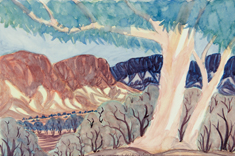[Leipzig] Aboriginal Art from Central Australia
Aboriginal Art from Central Australia
The exhibition, Aboriginal Art from Ntaria: Landscape paintings of the Hermannsburg School of Painting, will be held until March 23rd 2014 at the Grassi Museum of Ethnology in Leipzig, Germany.
Hermannsburg, a small mission station 115km south-west of Alice Springs in Central Australia, was the first center of modern Native Australian art in Australia. The exhibition presents the collection of the Hermannsburg artists from the collection of the Grassi Museum of Ethnology in Leipzig.
The artists who belong to the ethnic group of Aranda, show in 20 small-format landscape images, the close connection to their land. The acrylic and watercolor works are accompanied by photographs that represent the landscape around Hermannsburg, as well as some objects, such as books and ceramics.
Inspired by the English artist Rex Battarbee, Albert Namatjirra (1902 - 1959) began to paint landscapes in watercolors in 1934 and soon became a successful artist. Members of his family follow his style of painting today. This landscape painting in the classical style is called "Hermannsburg Aranda or art school." Only the Namatjira clan are allowed to belong to this group of painters, of which the fourth generation occurs successfully on the art market.
The Aranda live in the desert region in the center of the Australian continent. Their country is characterized by rugged mountains and hills, and canyons of red sand plains, which are covered with acacia and eucalyptus trees. The people there have a rich tradition of ceremonies, songs and stories that describe the land and its flora and fauna. In extensive ceremonial cycles, the preservation of nature and all its creatures is ensured. In these ceremonies sand paintings are made that describe certain sacred places and symbols with many points in an abstract way, then they are destroyed. Today's watercolor painting is a new facet of contemporary Australian Aboriginal Art.
Admission is free.View all Asia-Europe Museum Network members from Germany and Australia
Similar content
from - to
21 Sep 2013 - 08 Dec 2013
09 Apr 2017
from - to
17 Feb 2012 - 27 May 2012
posted on
03 Mar 2012
posted on
15 May 2012
posted on
15 Aug 2011



